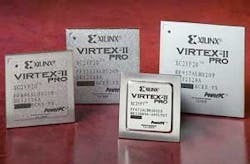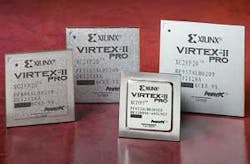Raytheon uses Xilinx FPGA for MicroLight radios on Land Warrior program
By John McHale
FULLERTON, Calif. - Engineers at Raytheon Networked Communication Systems in Fullerton, Calif., are using field-programmable gate arrays (FPGAs) from Xilinx in San Jose, Calif., for the company’s MicroLight radio.
The radio and ancillary equipment are going to General Dynamics C4 Systems in Taunton, Mass., for the U.S. Army’s Land Warrior program.
The first spiral of Land Warrior capability will include 26 MicroLight radios, 26 Voice Over IP (Internet Protocol) smart controllers, and situational awareness software for testing prior to early fielding to platoon and squad leaders in an experimental company-size military unit.
“Raytheon’s MicroLight radio is their next generation of EPLRS (Enhanced Position Location Reporting System) radio,” says Manuel Uhm DSP marketing manager at Xilinx. “It can automatically reconfigure itself to overcome line-of-sight limitations, as well as jamming threats.
“They are using a Virtex-II Pro as a system-on-chip (SOC) to do the modem processing, as well as run the application infrastructure and real-time operating system,” Uhm says.
“They are using both the embedded hard 405 PowerPC core, as well as a MicroBlaze soft PowerPC core. By dividing the management load across the hard and soft core, they are able to lower the overall clock frequency, thereby significantly decreasing power consumption. The SOC approach also results in significantly lower power consumption due to lower I/O requirements from not having to drive data between multiple processing devices.”
The Land Warrior program follows a spiral development strategy to introduce new technology to current and future forces.
The initial increment equips soldiers with a dismounted battle command system including the MicroLight radios and Smart Controllers. It will provide secure voice communications, position location, automatic reporting, and navigation for dismounted team leaders and above.
Echelons above the platoon level will be equipped with a Commander’s Digital Assistant that gives leaders expanded situational awareness, tactical-level messaging and fratricide avoidance. Raytheon customized its off-the-shelf designs to support the Land Warrior program.
The EPLRS contention-free networking architecture integrates current battlefield systems and ensures speedy data exchange in time-critical situation, Raytheon officials say.
EPLRS’ data-collection and communication capabilities cover a wide variety of missions-from air defense to logistics support and beyond.
In fire support missions, it simultaneously distributes artillery-fire requests and mission-support data to multiple destinations. In logistics support operations, the radio’s data-communication, position-location reporting, and navigation functions play an integral role.
Through the FBCB2 (Force XXI Battle Command Brigade and Below) system, EPLRS relays unit identification, position location, and unit operational-status data to the Maneuver Control Forces.
The data displays on the FBCB2 platform hosts and the EPLRS NCS (net control station) operator console, as well as on command-and-control center displays. Raytheon officials say. EPLRS provides the NCS operator with a situation awareness display of friendly unit locations. It also provides e-mail, reports, and other information to assist commanders during force deployments and maneuvers.
EPLRS also provides for future interoperability with systems such as the Joint Tactical Radio System.
Raytheon’s Networked Communication Systems has sold more than 14,000 EPLRS data radios, equipped F-16 fighter aircraft with situation awareness data links, and provided the network for Blue Force tracking and Future Combat Systems.
For more on Xilinx go online at www.xilinx.com. For more on Raytheon visit www.raytheon.com.

